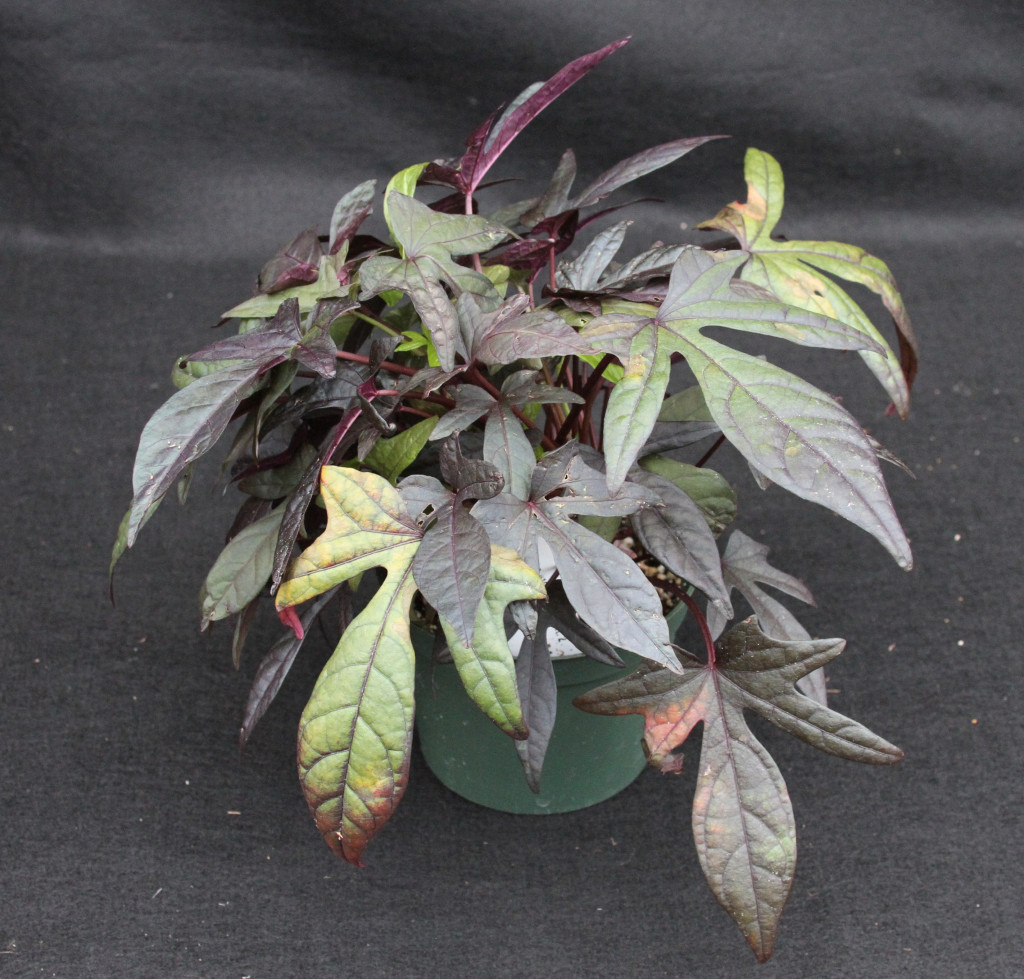
Intumescences: Further Investigations into an Elusive Physiological Disorder
In the December 2013 issue of GPN, we published an article that discussed the development of a physiological disorder known as intumescence. For those who may be unfamiliar, intumescences are small bumps or protrusions that develop on the surface of leaves, petioles and stems of affected ornamental crops. Common greenhouse-grown crops that develop this disorder are tomato (Solanum lycopersicum), cuphea (Cuphea spp.) and ornamental sweet potato (Ipomoea batatas).
Development on Multiple Species
In the previous article, we also mentioned the discrepancy and confusion that exists between the disorders oedema and intumescence. At Kansas State University, we wanted to look deeper into this difference and evaluate similar disorders on multiple plant species. The specific cultivars that we analyzed were ornamental sweet potato 'Blackie', tomato 'Maxifort', interspecific geranium 'Caliente Coral', and bat-faced cuphea (Cuphea llavea 'Tiny Mice'). We evaluated each disorder as it developed on each species, and we found interesting differences in how the intumescences developed. The term "lesion" will be used when describing growths on each species to improve readability and remove any bias from our presentation of the results.
One of our main goals was to evaluate the progression of development of lesions on each plant species. We targeted three distinct stages of development that were apparent in all four species: 1) initial lesion development and early expansion; 2) full expansion of the lesions and beginning stages of senescence; 3) complete senescence of the lesion and surrounding tissue (Figure 1, page 34). In addition to documenting these stages of development, we also found some distinct anatomical differences between lesions on these species. One such finding focused on the cell layers of the leaf actively involved in the development of the lesions. Specifically, we found that lesion development in geranium occurred solely within the leaf mesophyll — cells in the middle of the leaf cross-section, while lesions on ornamental sweet potato, tomato and cuphea involved both the mesophyll and epidermis — the outer layer of cells on a leaf. To put it simply, we discovered that lesion development on geranium differed from the other three species based on the type of leaf cells directly involved.
Another interesting phenomenon was observed with lesions on tomato and cuphea, in which the lesions actually collapsed. This collapse ultimately led to the senescence of the leaf tissue. The interesting thing about this collapse was that it not only affected the surface of the leaf where the lesions were developing, but also caused the death of all cell layers. This response was most clearly seen in tomato, as lesion development on the underside of the leaf also caused browning and death on the upper side as well.
Causative Factors and Differentiation of Nomenclature
In the previous article, we also briefly discussed causative factors. As we begin to try and differentiate between the disorders, it is important to not only evaluate the anatomy and morphology of these lesions but also the physiology behind why it seems each disorder is occurring. We found that light quality, specifically ultraviolet-B (UVB) radiation, was directly related to preventing or minimizing lesion development on ornamental sweet potato and tomato. However, UVB has been found to have no effect regarding development on geranium. Rather, lesion development on geranium is thought to be affected by water relations; specifically, that high humidity, warm root media and poor ventilation are conducive to development of the disorder. These findings lead to the supposition that "oedema" on geranium may have different causative factors and be regulated by different physiological systems than "intumescence" on ornamental sweet potato and tomato.
It is also important to consider that plants possess a limited means by which to respond to stress. In other words, while the morphological aspects between disorders may appear similar, the cause and mechanism by which these abnormal growths occur on each species may differ. For this reason, it is crucial to consider these causative factors alongside the morphological and anatomical aspects of lesion development to most accurately determine the appropriate terminology for each disorder. Our results point toward a differentiation in lesion nomenclature. Specifically that, lesions on geranium would be referred to as "oedema", while lesions on tomato and ornamental sweet potato would be referred to as "intumescence." This proposed differentiation was due not only to differences in causative factors involved, but also the differences in lesion anatomy we have documented.
Similarities to Pest Problems and Other Disorders?
Another confusing attribute surrounding oedema and intumescence is that their appearance is often similar to pest damage. This is most clearly observed with oedema development on geranium. Specifically, the latter stages of oedema development on geranium look remarkably similar to feeding damage from western flower thrips (Frankliniella occidentalis). Damage from thrips on geranium is often observed as pale yellow to dark brown spots on the underside of the leaf. Thrips will feed by piercing and dragging their mouthparts along the leaf tissue surface and then imbibing the cellular fluids that result. In the case of both thrips feeding damage and lesion development on geranium, the layer of cells on the underside of the leaf are compromised. This can cause damage done by thrips and oedema to looks incredibly similar, as both result in senesced tissue on the leaf underside. This damage observed from oedema has also been stated to look similar to injury caused by twospotted spider mite. For this reason, it is crucial to observe symptoms closely when determining whether a crop is suffering from pest damage versus oedema or intumescence development.
Ornamental sweet potato has been a crop of particular interest for the floriculture program at Kansas State University. As mentioned in the previous GPN article, we recently found that supplemental (UVB) radiation can reduce intumescence development in this species. This link to UVB stems from a peculiar observation associated with this disorder: that it primarily occurs when plants are produced in controlled environments. Supplemental UVB supplied in controlled environments provides the light quality that plants are exposed to naturally outdoors. With many greenhouse glazing materials filtering out UVB wavelengths, we have found that intumescences can be nearly prevented by supplementing UVB radiation. However, this method of prevention may not be practical in commercial greenhouses, as it has some drawbacks. In our study, plants developed leaf discoloration and deformities that were prevalent when the plant tissue was exposed to UVB wavelengths of light for extended periods of time. Moreover, health and safety for greenhouse workers is a concern. Further investigations into UVB exposure duration would be beneficial to determine practicality in the commercial setting. Thus, we recommended that one of the best means of avoiding intumescence development is for growers to produce resistant cultivars.
Cultivar Selection
We wanted to support our recommendation of producing "resistant cultivars" to avoid intumescences, by conducting a sweet potato cultivar screening trial to evaluate cultivar susceptibility to intumescence development. In spring 2014, we secured 36 commercially available ornamental sweet potato cultivars and evaluated them for
intumescence development. Data was collected at three time intervals over the course of the six-week study, with six replications of each cultivar evaluated for intumescence development at each interval. We found that out of the 36 cultivars trialed, 19 did not show any symptoms of intumescence development (Table 1, page 36). Cultivars that were especially symptomatic of intumescence development in controlled environments (based on 20 percent or more of leaves exhibiting intumescences) were 'Blackie', 'Black Heart', 'Desana Bronze', 'South of the Border Chipotle', 'Sweet Caroline Bronze', 'Sweet Caroline Sweetheart Red' and 'Tricolor'. There were a handful of other cultivars that
developed intumescences, however the percentage of leaves affected was less than 5 percent. This information provides a valuable resource to growers who seek to avoid this disorder. However, it raises many interesting questions about why we are seeing these differences in cultivar susceptibility. These differences in cultivar susceptibility are the target of future research at Kansas State University, as we hope to further understand the complex physiological interactions that may regulate the development of this disorder.
Intumescences: Further Investigations into an Elusive Physiological Disorder


 Video Library
Video Library 



















